May 2020 LIP of the Month
Restoration of the Pudasjärvi block using Paleoproterozoic dyke swarms and refinement of the Superia supercraton paleogeographic reconstruction
Sarah Davey
Geological Survey of Canada, Ottawa, Ontario, Canada
Department of Earth Sciences, Carleton University, Ottawa, Ontario, Canada
sarah.davey@carleton.ca

Figure 1. Magmatic barcodes (Bleeker, 2004) of the Superior and Karelia-Kola cratonic fragments. The dark grey, orange, blue, red and green horizontal bars indicate magmatic events discussed in this study. Light grey horizontal bars highlight other magmatic events matching in age. Superior age references: Krogh, 1994; Buchan et al., 1996; 1998; Heaman, 1997; Maurice et al., 2009; Ernst and Bleeker, 2010; Kastek et al., 2018; Davey et al., 2019; M. Hamilton pers. comm., 2019. Karelia-Kola age references: Pekkarinen and Lukkarinen, 1991; Vuollo et al., 1992; Amelin et al., 1995; Mutanen and Huhma, 2001; Räsänen and Huhma, 2001; Bayanova, 2006; Hanski et al., 2010; Fedotov et al., 2012; Martin et al., 2013; Salminen et al., 2014; Stepanova et al., 2014; 2015; 2017; Smolkin et al., 2015; Huhma et al., 2018; Erofeeva et al., 2019.
This LIP of the month is a summary of the paper:
Davey, S.C., Bleeker, W., Kamo, S.L, Vuollo, J., Ernst, R.E., and Cousens, B.L. in press. Archean block rotation in Western Karelia: Resolving dyke swarm patterns in metacraton Karelia-Kola for a refined paleogeographic reconstruction of supercraton Superia. Lithos 105553.
The Paleoproterozoic paleogeography of the Karelia-Kola craton and its role within the Superia supercraton (Bleeker, 2003) paleogeographic reconstruction is debated primarily because of conflicting large igneous province (LIP) and paleomagnetic datasets. As presented by Bleeker and Ernst (2006) and Ernst and Bleeker (2010) the Superia supercraton paleogeographic reconstruction synthesizes evidence that the Karelia-Kola (Finland/Russia), Wyoming (USA), Hearne, and Superior (Canada) cratons were nearest-neighbours from the late Archean to the Paleoproterozoic based on multiple LIPs that match in time and geometry (Fig. 1). However, paleomagnetic data from Karelia-Kola provide inconsistent paleolatitudes due to complicated overprints and poor exposure that limits field tests. As a result, previous paleomagnetic studies have questioned whether Karelia-Kola shared an intimate common history with Superior, Wyoming and Hearne into the Paleoproterozoic.
An added complication of the LIP record in Karelia-Kola is that Western Karelian basement has been fragmented and reworked by the ca. 1.92-1.79 Ga Svecofennian orogeny into four crustal blocks including Pudasjärvi, Iisalmi, Kuhmo, and Taivalkoski (Fig. 2; Vuollo and Huhma, 2005). Dyke swarms older than 1.92 Ga are not consistent or continuously traceable across all the cratonic blocks, especially between the Pudasjärvi, and Taivalkoski and Kuhmo blocks.
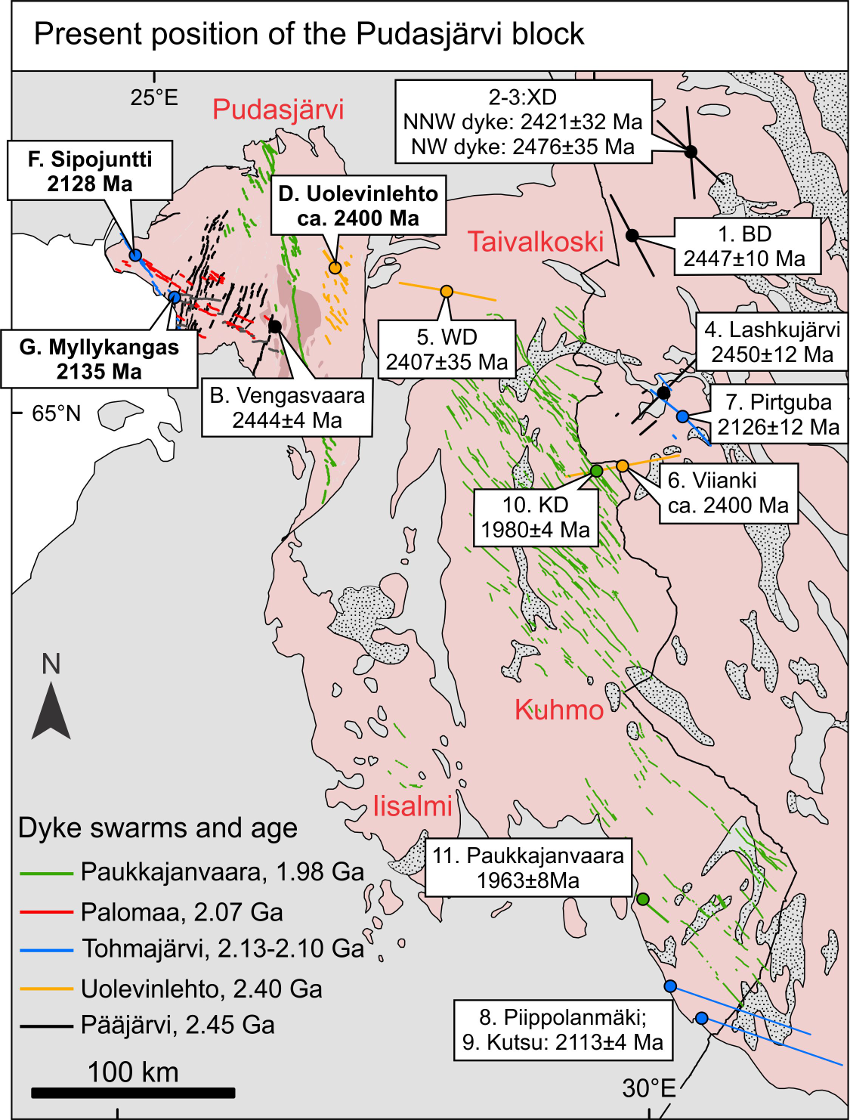
Figure 2. Map of Western Karelia including Archean blocks and mafic dyke swarms with U-Pb geochronology localities. Ages in bold text are those dated in this study. Other ages from: Pekkarinen and Lukkarinen, 1991; Vuollo et al., 1992; Mertanen et al., 1999; Salminen et al., 2014; Stepanova et al., 2014; 2015; 2017; Huhma et al., 2018. Modified after Davey et al., in press.
Three new U-Pb ages are obtained on dykes from the Pudasjärvi block to address inconsistencies between dyke swarm geometries from the Archean blocks of Western Karelia. New U-Pb isotope dilution thermal ionisation mass spectrometry (ID-TIMS) ages determined for dykes from the Pudasjärvi block include the 30 m-wide Uolevinlehto dyke at 2400 Ma trending 325°, the 30 m-wide Myllykangas dyke at 2135 Ma trending 350°, and the 75 m-wide Sipojuntti dyke at 2128 Ma trending 320° (locations are indicated in Fig. 2; an example of our geochronology results is shown in Fig. 3). Combined with previous ages (mostly U-Pb), we report an updated dyke swarm classification scheme in the Pudasjärvi block including four dated dyke swarms: ca. 2.45 Ga Pääjärvi, ca. 2.40 Ga Uolevinlehto, ca. 2.13-2.10 Ga Tohmajärvi-Pirtguba, and 2.07 Ga Palomaa. A fifth dyke swarm, the ca. 1.98 Ga Paukkajanvaara swarm, is inferred based on high aeromagnetic signatures matching dated dykes in the Kuhmo block. A sixth dyke swarm, with an east-west trend, was also found in the field but efforts to date the swarm with U-Pb ID-TIMS geochronology were unsuccessful.
With the exception of the 2.07 Ga Palomaa dyke swarm (dated using Sm-Nd methods by Huhma et al., 2018) the dyke swarms from the Pudasjärvi block have age matches in the Taivalkoski and Kuhmo blocks farther to the east. The trends of these contemporaneous dyke swarms in the Pudasjärvi block compared to those in the Taivalkoski and Kuhmo blocks are systematically offset (Vuollo et al., 2000). A ‘best fit’ alignment of the ca. 2.45 Ga Pääjärvi, ca. 2.40 Uolevinlehto, ca. 2.13-2.10 Ga Tohmajärvi-Pirtguba, and ca. 1.98 Ga Paukkajanvaara swarms is obtained when the Pudasjärvi block is restored by rotating it 35° counter clockwise (Fig. 4). With the youngest dykes affected by rotation dated at ca. 1.98 Ga, we attribute the 35° clockwise vertical axis rotation to the ca. 1.92-1.79 Ga Svecofennian orogeny. However, as discussed by Vuollo et al. (2000), minor rotation events may have occurred through the Paleoproterozoic but more detailed studies are required to better understand the full history of deformation and rotation of the Pudasjärvi block.
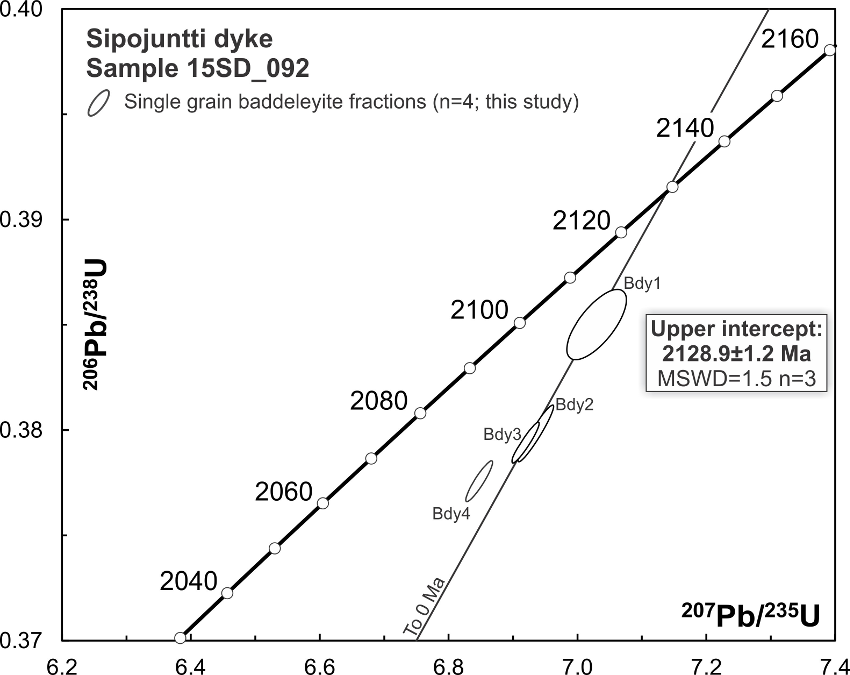
Figure 3. An example of the U-Pb ID-TIMS geochronology results after Davey et al. (in press). Four single grain baddeleyite analyses for from the Sipojuntti dyke. The three least discordant data plot along a regression line anchored at 0 Ma with an upper intercept age of 2128.9±1.2 Ma.
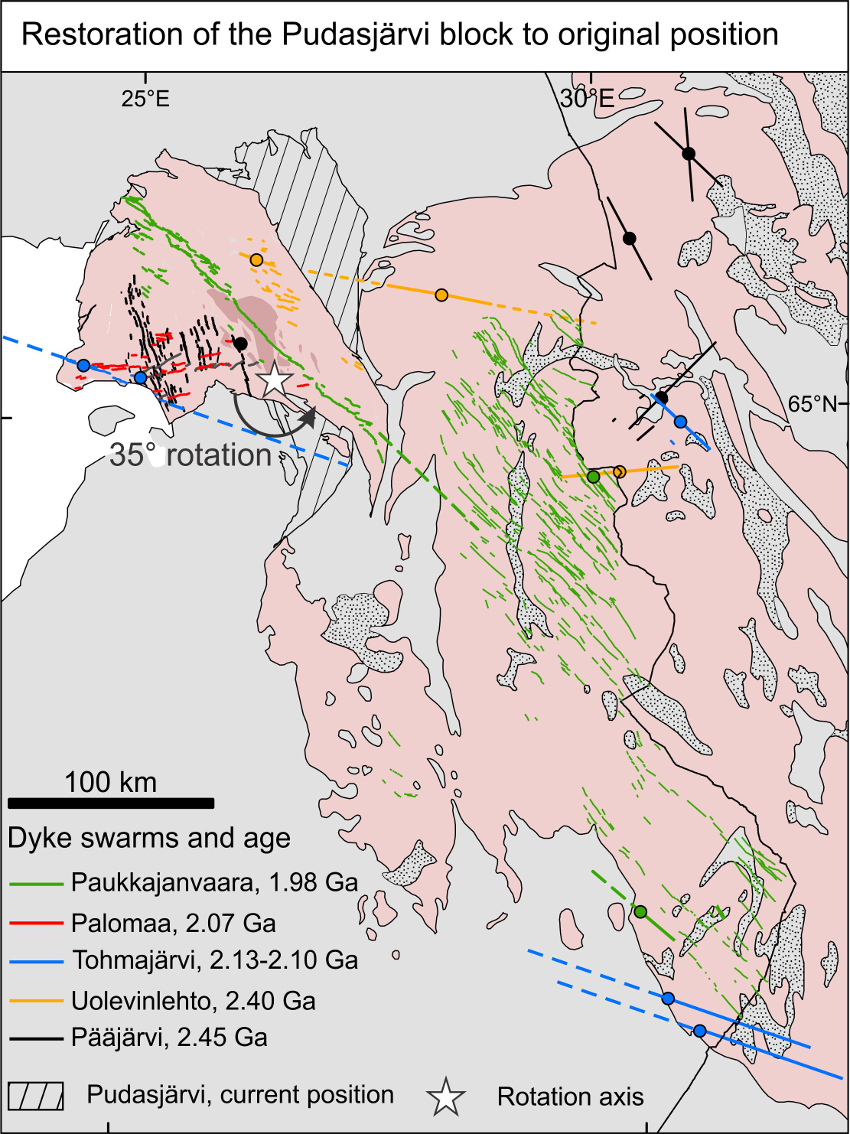
Figure 4. Restoration of the Pudasjärvi block to original position modified after Davey et al. (in press). Dashed lines show extrapolated dyke swarm trends.
With improved regional geometric constraints on the Paleoproterozoic dyke swarms in the Karelia-Kola metacraton (Abdelsalam et al., 2002) we can consider their implications within the context of the Superia supercraton paleogeographic reconstruction. Bleeker and Ernst (2006) and Ernst and Bleeker (2010) positioned the Karelia-Kola cratonic fragment at the southeastern margin of the Superior craton based on correlations between the ca. 2.45 Ga Pääjärvi and Matachewan dykes, ca. 2.22 Ga Karjalitic sills and Ungava LIP (Klotz, Senneterre and Maguire dykes, and Nipissing sills; Davey et al., 2019), and the ca. 2.13-2.10 Ga Tohmajärvi-Pirtguba and Marathon dykes (Fig. 1). In the proposed configuration of Superia, the proximity between Superior and Karelia-Kola was guided by the hypothesis that the Nipissing sills directly fed the Karjalitic sills. If true, the Karjalitic sills should have εNdT=2.22Ga values that are either equal to or lower (to account for additional crustal assimilation) than those of the Nipissing sills. The Nipissing sills have εNdT=2.22Ga values between -0.4 and -6.0 (Lightfoot and Naldrett, 1996; Davey et al., 2019) whereas the εNdT=2.22Ga values of the Karjalitic sills range from +2.1 to -0.5 (Hanski et al., 2010). The consistently higher εNdT=2.2Ga values of the Karjalitic sills compared to the Nipissing sills indicate that the Karjalitic sills are not the direct ‘downstream’ continuation of the Nipissing sills. Consequently, the tight fit between Karelia-Kola and Superior in the Superia supercraton paleogeographic reconstruction by Bleeker and Ernst (2006) and Ernst and Bleeker (2010) can be relaxed.
The updated Superia supercraton paleogeographic reconstruction by Davey et al. (in press) relies on geometries from the ca. 2.45 Ga Pääjärvi, 2.40 Ga Uolevinlehto and ca. 2.13-2.10 Ga Tohmajärvi dyke swarms (Fig. 5; eastern Superior in its present day position). In this configuration, Karelia-Kola is placed farther south of Superior and adjacent to the eastern margin of Wyoming. The Pääjärvi dykes approximately trend towards the Matachewan magmatic centre and the Tohmajärvi-Pirtguba dykes trend towards the Marathon magmatic centre. A new magmatic centre located between Karelia-Kola and Wyoming is proposed based on the radiating swarm pattern formed by ca. 2.40 Ga Uolevinlehto dyke (plus other ca. 2.40 Ga dykes across Karelia-Kola; see Erofeeva et al., 2019), Ringvassøy dykes in the West Troms Basement (Norway; Kullerud et al., 2006) and du Chef dykes (Canada; Krogh, 1994). Lastly, the ca. 2.07 Ga Palomaa dyke from the Pudasjärvi block trends towards the Fort Frances magmatic centre.
The updated position of Karelia-Kola within the Superia supercraton paleogeographic reconstruction is consistent with the few paleomagnetic virtual geomagnetic poles (VGPs) that have U-Pb ages and positive field tests confirming primary magnetization (Fig. 6). These include the ca. 2.50 Ga Shalskiy dyke VGP overlapping with the Mistassini pole and the ca. 2.05 Ga Kuetsyarvi VGP overlapping with the Fort Frances pole (Torsvik and Meert, 1995; Buchan et al., 1996; 1998; Mertanen et al., 2006; Melezhik et al., 2007; Bleeker et al., 2008; Lubnina et al., 2017). Additionally, the ca. 2.45 Ga D’ VGP of Mertanen et al. (1999) overlaps with the contemporaneous Matachewan pole and the D VGP of Mertanen et al. (1999) overlaps with ca. 2.22 Ga Senneterre pole from the Superior craton. Overlap between the D VGP from Mertanen et al. (1999) and ca. 2.22 Ga Senneterre dyke pole may be explained if the D VGP represents a regional overprint related to the widespread intrusion of the ca. 2.22 Ga Karjalitic sills located across Karelia.
Here we show that a nearest-neighbour connection between Karelia-Kola and Superior with the context of supercraton Superia is supported by harmonizing LIP and paleomagnetic datasets. Still, more work is required to understand the full extent of supercraton Superia.
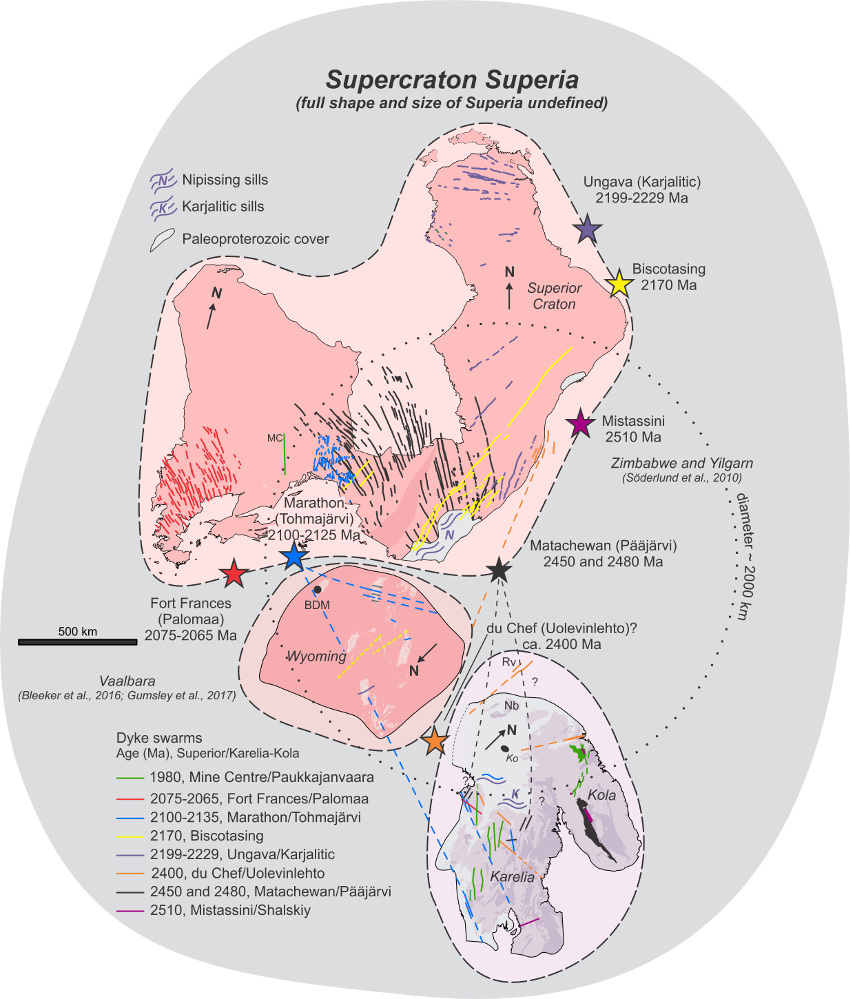
Figure 5. Updated Superia supercraton paleogeographic reconstruction after Davey et al. (in press). The Superia reconstruction joins Superior, Wyoming and Karelia-Kola in the late Neoarchean to early Paleoproterozoic based on LIPs and their radiating dyke swarms. Reference frame is the modern position of the eastern Superior craton. Western Superior rotated 14° clockwise relative to eastern Superior based on paleomagnetic analysis (Evans and Halls, 2010). The 2000 km-diameter circle around the Matachewan magmatic centre indicates a typical size of an impinging plume head. Dashed lines from the Matachewan magmatic centre towards the Pääjärvi dykes show the subtle curvature in trends that may reflect the uncertainty in the overall trend of the Pääjärvi swarm. Extrapolated dyke trends are also shown for the Tohmajärvi dykes towards the Marathon magmatic centre and for the Uolevinlehto and du Chef dykes towards their tentative magmatic centre. Present day north arrows show relative orientation of each cratonic fragment. Minimum size estimates of Archean fragments represented by pink and purple shapes outlined by black dashed lines. Superia extent is light grey, approximate size and shape undefined. Abbreviations: BDM - Blue Draw Metagabbro, ca. 2450 Ma; MC - Mine Centre, 1980 Ma (M. Hamilton, pers. comm., 2019); Nb - Norbotten craton; Ko – Koitelainen layered intrusion; Rv – Ringvassøy dykes. See Davey et al. (in press) for references.
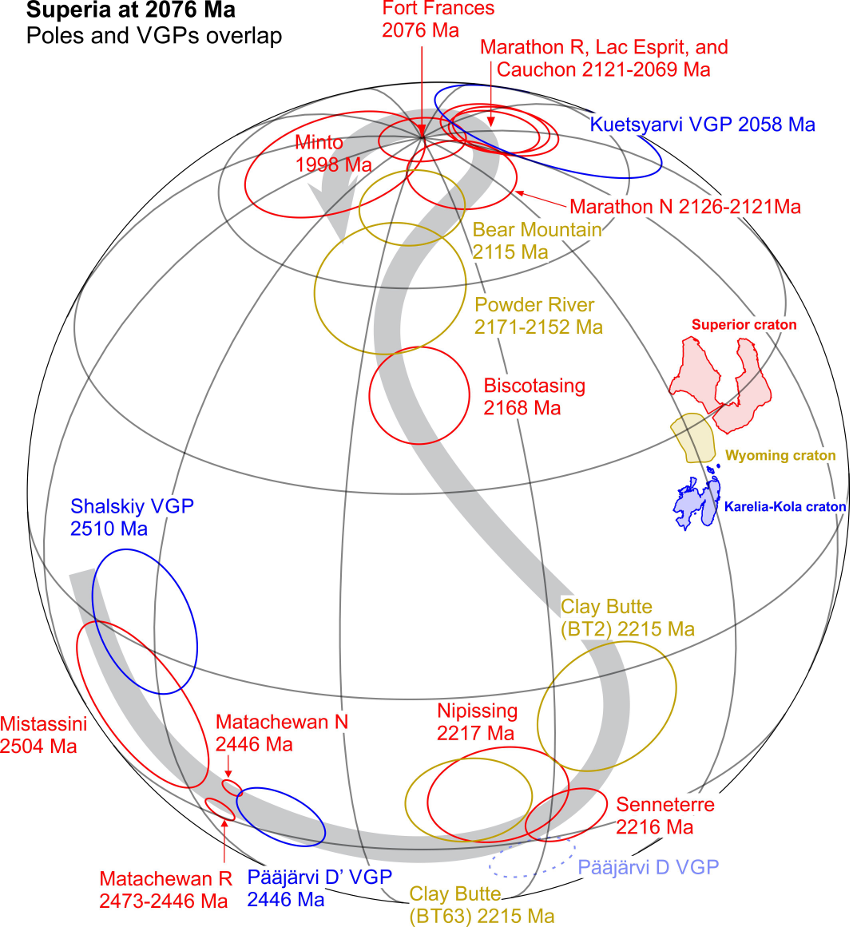
Figure 6. 3-D orthographic projection of the Superia supercraton paleogeographic reconstruction after Davey et al. (in press). The virtual geomagnetic poles (VGPs) from Karelia-Kola (blue) are internally consistent with poles from Superior (red) and Wyoming (gold) cratons. The blue dashed ellipse is the D component of Mertanen et al. (1999). R: Reverse polarity; N: Normal polarity. See the supplementary file from Davey et al. (in press) for further details and references. Data plotted using GPlates (Müller et al., 2018).
Acknowledgements
The authors would like to thank Hannu Huhma, Esa Heilimo, Asko Kapyaho, and Peter Sorjonen-Ward of the Geological Survey of Finland for participating in field work and helpful discussions. Anglo-American plc and First Quantum Minerals Ltd. are thanked for their in-kind support in Finland, and Jessica N. Nguyen is thanked for her hospitality in Toronto. Dave Evans kindly provided instruction using GPlates.
References
Abdelsalam, M G, Liegeois, J-P, Stern, R J, 2002. The Saharan metacraton. J. Afr. Sci. 34, 119–136.
Amelin, Y V, Heaman, L M, Semenov, V S, 1995. U-Pb geochronology of layered mafic intrusions in the eastern Baltic Shield: implications for the timing and duration of Paleoproterozoic continental rifting. Precambrian Res. 75, 31–46
Bayanova, T B, 2006. Baddeleyite: a promising geochronometer for alkaline and basic magmatism. Petrology 14, 187–200.
Bleeker, W, 2003. The late Archean record: a puzzle in ca. 35 pieces. Lithos 71, 99–134.
Bleeker, W., 2004. Taking the Pulse of Planet Earth; A proposal for a New Multi-disciplinary Flagship Project in Canadian Solid Earth Sciences. Geoscience Canada 31, 179–190.
Bleeker, W., Ernst, R.E., 2006. Short-lived mantle generated magmatic events and their dyke swarms: the key unlocking Earth’s paleogeographic record back to 2.6 Ga. In: Hanski, E., Mertanen, S., Rämö, T., Vuollo, J. (Eds.), Dyke Swarms—Time Markers of Crustal Evolution. Taylor and Francis/Balkema. pp. 3–26.
Bleeker, W, Hamilton, M A, Ernst, R E, Kulikov, V S, 2008. The search for Archean- Paleoproterozoic supercratons: New constraints on Superior-Karelia-Kola correlations within supercraton Superia, including the first ca. 2504 Ma (Mistassini) ages from Karelia. In: International Geological Congress 33, August 6-14, Oslo, Norway.
Buchan, K L, Halls, H C, Mortensen, J K, 1996. Paleomagnetism, U-Pb geochronology, and geochemistry of Marathon dykes, Superior Province, and comparison with the Fort Frances swarm. Can. J. Earth Sci. 33 (12), 1583–1595.
Buchan, K L, Mortensen, J K, Card, K D, Percival, J A, 1998. Paleomagnetism and U-Pb geochronology of diabase dyke swarms of Minto block, Superior Province, Quebec, Canada. Can. J. Earth Sci. 35, 1054–1069.
Davey, S., Bleeker, W., Kamo, S., Easton, M., Sutcliffe, R.H., 2019. Ni-Cu-PGE potential of the Nipissing sills as part of the ca. 2.2 Ga Ungava large igneous province. In: Rogers, N. (Ed.), Targeted Geoscience Initiative: 2018 Report of Activities. In: Geological Survey of Canada, Open File, 8549. pp. 403–419.
Ernst, R.E., Bleeker, W., 2010. Large igneous provinces (LIPs), giant dyke swarms, and mantle plumes: significance for breakup events within Canada and adjacent regions from 2.5 Ga to the present. Can. J. Earth Sci. 47, 695–739.
Erofeeva, K G, Stepanova, A V, Samsonov, A V, Larionaova, YuO, Egorova, S V, Arzamastsev, A A, Kovalchuk, E V, 2019. 2.4 Ga mafic dikes and Sills of Northern Fennoscandia: petrology and crustal evolution. J. Petrol. 27, 19–46.
Evans, D A D, Halls, H C, 2010. Restoring Proterozoic deformation within the superior craton. Precambrian Res. 183, 474–489.
Fedotov, Z A, Bayanova, T B, Serov, P A, 2012. Spatiotemporal relationships of dike magmatism in the Kola region, the Fennoscandian Shield. Geotectonics 46, 412–426.
Hanski, E, Huhma, H, Vuollo, J, 2010. SIMS zircon ages and Nd isotope systematics of the 2.2 Ga mafic intrusions in northern and eastern Finland. Bull. Geol. Surv. Finland 82, 31–62.
Heaman, L M, 1997. Global mafic magmatism at 2.45 Ga: Remnants of an ancient large igneous province? Geology 25, 299–302.
Huhma, H, Hanski, E, Kontinen, A, Vuollo, J, Manttari, I, Lahaye, Y, 2018. Sm-Nd and U-Pb isotope geochemistry of the Palaeoproterozoic mafic magmatism in eastern and northern Finland. Geol. Surv. Finl. Bull. 405, 153.
Kastek, N, Ernst, R E, Cousens, B L, Kamo, S L, Bleeker, W, Soderlund, U, Baragar, W R A, Sylvester, P, 2018. U-Pb geochronology and geochemistry of the Povungnituk group of the cape smith belt: part of a craton-scale circa 2.0 Ga minto-povungnituk large Igneous Province, Northern Superior Craton. Lithos 320, 315–331.
Krogh, T E, 1994. Precise U-Pb ages for Grenvillian and pre-Grenvillian thrusting of Proterozoic and Archean metamorphic assemblages in the Grenville Front tectonic zone, Canada. Tectonics 13, 963–982.
Kullerud, K, Skjerlie, K P, Corfu, F, Jesus, D, 2006. The 2.40 Ga Ringvassøy mafic dykes, West Troms Basement complex, Norway: the concluding act of early Palaeoproterozoic continental breakup. Precambrian Res. 150, 183–200.
Lightfoot, P. C. and Naldrett, A. J., 1996. Analytical data for Nipissing Intrusions. Ontario Geological Survey, Miscellaneous Release—Data 19.
Lubnina, N V, Pisarevsky, S A, Stepanova, A V, Bogdanova, S V, Sokolov, S J, 2017. Fennoscandia before Nuna/Columbia: Paleomagnetism of 1.98–1.96 Ga mafic rocks of the Karelian craton and paleogeographic implications. Precambrian Res. 292, 1–12.
Martin, A P, Condon, D J, Prave, A R, Melezhik, V A, Lepland, A, Fallick, A E, 2013. Dating the termination of the Palaeoproterozoic Lomagundi-Jatuli carbon isotopic event in the North Transfennoscandian Greenstone Belt. Precambrian Res. 224, 160–168.
Maurice, C, David, J, O’Neil, J, Francis, D, O’Neil, J, Francis, D, 2009. Age and tectonic implications of Paleoproterozoic mafic dyke swarms for the origin of 2.2 Ga enriched lithosphere beneath the Ungava Peninsula, Canada. Precambrian Res. 174, 163–180.
Melezhik, V A, Huhma, H, Condon, D J, Fallick, A E, Whitehouse, M J, 2007. Temporal constraints on the Paleoproterozoic Lomagundi-Jatuli carbon isotopic event. Geology 35 (7), 655–658.
Mertanen, S, Halls, H C, Vuollo, J I, Pesonen, L J, Stepanov, V S, 1999. Paleomagnetism of 2.44 Ga mafic dykes in Russian Karelia, eastern Fennoscandian shield – implications for continental reconstructions. Precambrian Res. 98, 197–221.
Mertanen, S, Vuollo, J I, Huhma, H, Arestova, N A, Kovalenko, A, 2006. Early Paleoproterozoic–Archean dykes and gneisses in Russian Karelia of the Fennoscandian Shield—New paleomagnetic isotope age and geochemical investigations. Precambrian Res. 144 (3–4), 239–260.
Müller, R D, Cannon, J, Qin, X, Watson, R J, Gurnis, M, Williams, S, Pfaffelmoser, T, Seton,
M, Russell, S H J, Zahirovic, S, 2018. GPlates: Building a virtual Earth through deep time. Geochem. Geophys. Geosyst. 19 (7), 2243–2261.
Mutanen, T, Huhma, H, 2001. U-Pb geochronology of the Koitelainen, Akanvaara and Keivitsa layered intrusions and related rocks. In: Vaasjoki, M (Ed.), Radiometric Age Determinations from Finnish Lapland and Their Bearing on the Timing of Precambrian Volcano-Sedimentary Sequences. In: Special Paper, 33. Geol. Surv. Finland, pp. 229–246.
Pekkarinen, L J, Lukkarinen, H, 1991. Paleoproterozoic volcanism in the Kiihtelysvaara – Tohmajärvi district, eastern Finland. Geol. Surv. Finl. Bull. 357, 38.
Rasanen, J, Huhma, H, 2001. U-Pb datings in the Sodankyla Schist Area, Central Finnish Lapland. In: Vaasjoki, M (Ed.), Radiometric Age Determinations from Finnish Lapland and Their Bearing on the Timing of Precambrian Volcano-Sedimentary Sequences. In: Special Paper, 33. Geol. Surv. Finland, pp. 153–1833.
Salminen, J, Halls, H C, Mertanen, S, Pesonen, L J, Vuollo, J, Soderlund, U, 2014. Paleomagnetic and geochronological studies on Paleoproterozoic diabase dykes of Karelia, East Finland-Key for testing the Superia supercraton. Precambrian Res. 244, 87–99.
Smolkin, V F, 1997. The Paleoproterozoic (2.5–1.7 Ga) Midcontinent rift system of the northeastern Fennoscandian Shield. Can. J. Earth Sci. 34, 426–443.
Stepanova, A V, Samsonov, A V, Salnikova, E B, Puchtel, I S, Larionova, Y, Larionov, A N, Stepanov, V S, Shapovalov, Y B, Egorova, S V, 2014. Palaeoproterozoic continental MORB-type tholeiites in the Karelian Craton: Petrology, geochronology, and tectonic setting. J. Petrol. 55, 1719–1751.
Stepanova, A V, Salnikova, E B, Samsonov, A V, Egorova, S V, Larionova, Y O, Stepanov, V S, 2015. The 2.31 Ga mafic dykes in the Karelian Craton, eastern Fennoscandian shield: U–Pb age, source characteristics and implications for continental break-up processes. Precambrian Res. 259, 43–57.
Stepanova, A V, Salnikova, E B, Samsonov, A, Larionova, YuO, Egorova, S V, Savatenkov, V M, 2017. The 2405 Ma Doleritic Dyke in the Karelian Craton: a Fragment of a Paleoproterozoic large Igneous Province. Dokl. Earth Sci. 472, 72–77.
Torsvik, T H, Meert, J G, 1995. Early Proterozoic palaeomagnetic data from the Pechanga
Zone (north-west Russia) and their bearing on Early Proterozoic palaeogeography.
Geophys. 122 (2), 520–536.
Vuollo, J, Huhma, H, Lehtonen, M I, 2005. Paleoproterozoic mafic dikes in NE Finland. In:
Nurmi, P A, Ramo, O T, Condie, K C (Eds.), Developments in Precambrian Geology. Elsevier Science, pp. 195–236.
Vuollo, J, Piirrainen, T, Huhma, H, 1992. Two early Proterozoic tholeiitic diabase dyke swarms in the Koli-Kaltimo area, eastern Finland - their geological significance. Geol. Surv. Finl. Bull. 363, 30.
Vuollo, J., Huhma, H., Pesonen, L.J., 2000. Mafic Dyke swarms – geological evolution of the Palaeoproterozoic in the Fennoscandian shield. In: Pesonen, L.J., Korja, A., Hjelt, S.-E. (Eds.), Lithosphere 2000 – A Symposium.
